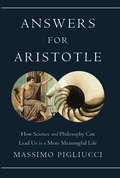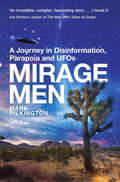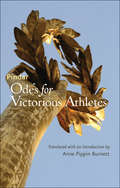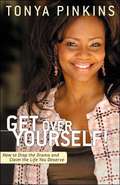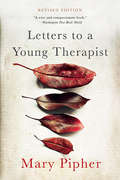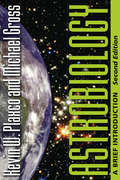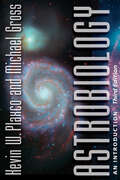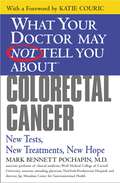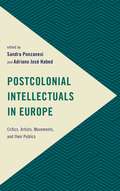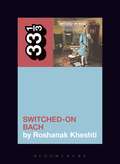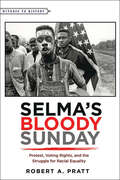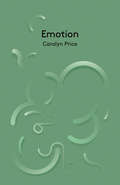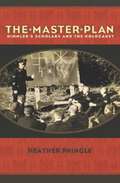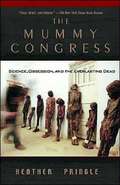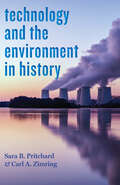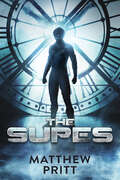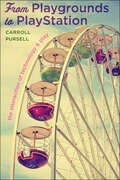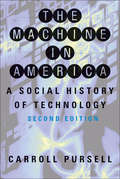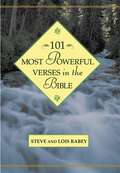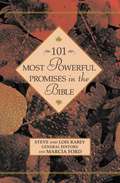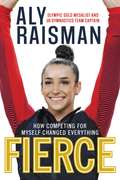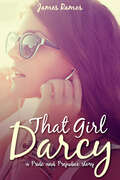- Table View
- List View
Answers for Aristotle: How Science and Philosophy Can Lead Us to A More Meaningful Life
by Massimo PigliucciHow should we live? According to philosopher and biologist Massimo Pigliucci, the greatest guidance to this essential question lies in combining the wisdom of 24 centuries of philosophy with the latest research from 21st century science. In Answers for Aristotle, Pigliucci argues that the combination of science and philosophy first pioneered by Aristotle offers us the best possible tool for understanding the world and ourselves. As Aristotle knew, each mode of thought has the power to clarify the other: science provides facts, and philosophy helps us reflect on the values with which to assess them. But over the centuries, the two have become uncoupled, leaving us with questions—about morality, love, friendship, justice, and politics—that neither field could fully answer on its own. Pigliucci argues that only by rejoining each other can modern science and philosophy reach their full potential, while we harness them to help us reach ours. Pigliucci discusses such essential issues as how to tell right from wrong, the nature of love and friendship, and whether we can really ever know ourselves—all in service of helping us find our path to the best possible life. Combining the two most powerful intellectual traditions in history, Answers for Aristotle is a remarkable guide to discovering what really matters and why.
Mirage Men: A Journey into Disinformation, Paranoia and UFOs.
by Mark PilkingtonSeeking the truth about UFOs in America, Mark Pilkington and John Lundberg uncover a 60 year-old story stranger than any conspiracy thriller. Through the fascinating account of their quest Mark Pilkington reveals the long history of UFOria and its parallels in little known tales from the murky worlds of espionage, psychological warfare and advanced military technology. Along the way he discovers that the truth about flying saucers is stranger and more complex than either the ufologists or debunkers would have us believe. As he crossed the US meeting intelligence agents, disinformation specialists and UFO hunters Pilkington was confronted with a dizzying array of ever more outrageous claims and counter claims. As a result he began to suspect that, instead of covering up stories of crashed flying saucers, alien contacts and secret underground bases, the US intelligence agencies had actually been promoting them all along. Meanwhile he has to deal with his own uncertainties, the suspicions of the UFO community and a partner who is starting to believe that conspiracy theorists might be right after all.With a fresh, funny and objective approach, Pilkington is the ideal guide to steer us through these strange territories, where nothing is quite as it seems and reality is just a matter of managing perceptions.
Odes for Victorious Athletes (Johns Hopkins New Translations from Antiquity)
by PindarYou've just won the gold medal, what are you going to do? In Ancient Greece, your patron could throw a feast in your honor and have a poet write a hymn of praise to you. The great poet Pindar composed many such odes for victorious athletes. Esteemed classicist Anne Pippin Burnett presents a fresh and exuberant translation of Pindar's victory songs.The typical Pindaric ode reflects three separate moments: the instant of success in contest, the victory night with its disorderly revels, and the actual banquet of family and friends where the commissioned poem is being offered as entertainment. In their essential effect, these songs transform a physical triumph, as experienced by one man, into a sense of elation shared by his peers—men who have gathered to dine and to drink.Athletic odes were presented by small bands of dancing singers, influencing the audience with music and dance as well as by words. These translations respect the form of the originals, keeping the stanzas that shaped repeating melodies and danced figures and using rhythms meant to suggest performers in motion.Pindar's songs were meant to entertain and exalt groups of drinking men. These translations revive the confident excitement of their original performances.
Get Over Yourself!: How to Drop the Drama and Claim the Life You Deserve
by Tonya PinkinsMost of us think we know what we want, and even why we can't get it. In her frank and inspiring book, Tonya Pinkins, star of television and Broadway, shows readers techniques and exercises that help them develop their own processes for obtaining their goals. This is tough love, Tonya style.In addition to being an actress and singer, Tonya has helped hundreds of people with her catalytic motivational seminars. She herself has seen the heights and the depths: from teen star to Tony Award winner to divorced mother on welfare to spiritual student to soaring success and unstoppable celebrity, delivering her magnificent solo performance at the 2004 Tony Awards show. In Get Over Yourself!, she takes the principles that helped her to succeed and puts them into a book that reaches out and grabs readers searching for a better way of life.
Letters to a Young Therapist: Stories Of Hope And Healing By The Author Of The Bestselling Surviving Ophelia (Letters To A Young... Ser.)
by Mary PipherFrom "one of America's best-known psychologists" (Chicago Tribune) and the bestselling author of Women Rowing North and Reviving Ophelia, an essential and inspiring book for therapists and anyone seeking to live a good lifeMary Pipher's groundbreaking investigation of America's "girl-poisoning culture," Reviving Ophelia, established its author as one of the nation's foremost authorities on family issues. In Letters to a Young Therapist, Pipher shares what she has learned in thirty years of clinical practice, helping warring families, alienated adolescents, and harried professionals restore peace and beauty to their lives. Through an exhilarating mix of storytelling and sharp-eyed observation, Pipher reveals her refreshingly inventive approach to therapy-fiercely optimistic, free of dogma or psychobabble, and laced with generous warmth and practical common sense. Whether she's recommending daily swims for a sluggish teenager, encouraging a timid husband to become bolder, or simply bearing witness to a bereaved parent's sorrow, Pipher's compassion and insight shine from every page. With a preface by the author addressing recent changes in therapy and the surprising challenges of the digital age, Letters to a Young Therapist is a powerfully engaging guide to living a healthy life.
Astrobiology: A Brief Introduction
by Kevin W. Plaxco Michael GrossInformed by new planetary discoveries and the findings from recent robotic missions to Mars, Jupiter, and Saturn, scientists are rapidly replacing centuries of speculation about potential extraterrestrial habitats with real knowledge about the possibility of life outside our own biosphere—if it exists, and where. This second edition of Kevin W. Plaxco and Michael Gross’s widely acclaimed text incorporates the latest research in astrobiology to bring readers the most comprehensive, up-to-date, and engaging introduction to the field available.Plaxco and Gross expand their examination of the origin of chemical elements, the developments that made the Universe habitable, and how life continues to be sustained. They discuss in great detail the formation of the first galaxies and stars, the diverse chemistry of the primordial planet, the origins of metabolism, the evolution of complex organisms, and the feedback regulation of Earth's climate. They also explore life in extreme habitats, potential extraterrestrial habitats, and the current status of the search for extraterrestrial life.Weaving together the relevant threads of astronomy, geology, chemistry, biophysics, and microbiology, this broadly accessible introductory text captures the excitement, controversy, and progress of the dynamic young field of astrobiology. New to this edition is a glossary of terms and an epilogue recapping the key unanswered questions, making Astrobiology an ideal primer for students and, indeed, for anyone curious about life and the Universe.
Astrobiology: An Introduction
by Kevin W. Plaxco Michael GrossExploring the potential for extraterrestrial life and the origins of our own planet, this comprehensive introduction to astrobiology is updated with the latest findings.Informed by the discoveries and analyses of extrasolar planets and the findings from recent robotic missions across the solar system, scientists are rapidly replacing centuries of speculation about potential extraterrestrial habitats with real knowledge about the possibility of life outside our own biosphere—if it exists, and, if so, where. Casting new light on the biggest questions there are—how did we get here, and who else might be out there?—this third edition of Kevin W. Plaxco and Michael Gross's widely acclaimed Astrobiology incorporates a decade's worth of new developments in space to bring readers the most comprehensive, up-to-date, and engaging introduction to the field available.Plaxco and Gross examine the factors that make our Universe habitable, from the origin of chemical elements and the formation of the first galaxies and stars to the birth and composition of the planets. They describe the latest thinking about the origins of life, explain the evolution of metabolism and the development of complex organisms. In order to assess the limits for life elsewhere, they also explore life in extreme habitats and reveal how it informs the search for potential extraterrestrial habitats—ones that might support extraterrestrial life. New and updated illustrations enhance the book throughout.Sharing fascinating findings from the comet mission Dawn, the visit of New Horizons to Pluto, and the work of the Deep Carbon Observatory, which has revealed an incredible underground biosphere within our own planet, Plaxco and Gross weave together cosmology, astrophysics, geology, biochemistry, biophysics, and microbiology. From neutron star mergers to the survival skills of tardigrades, this fascinating book is an ideal primer for students or anyone curious about life and the Universe.
Astrobiology: An Introduction
by Kevin W. Plaxco Michael GrossExploring the potential for extraterrestrial life and the origins of our own planet, this comprehensive introduction to astrobiology is updated with the latest findings.Informed by the discoveries and analyses of extrasolar planets and the findings from recent robotic missions across the solar system, scientists are rapidly replacing centuries of speculation about potential extraterrestrial habitats with real knowledge about the possibility of life outside our own biosphere—if it exists, and, if so, where. Casting new light on the biggest questions there are—how did we get here, and who else might be out there?—this third edition of Kevin W. Plaxco and Michael Gross's widely acclaimed Astrobiology incorporates a decade's worth of new developments in space to bring readers the most comprehensive, up-to-date, and engaging introduction to the field available.Plaxco and Gross examine the factors that make our Universe habitable, from the origin of chemical elements and the formation of the first galaxies and stars to the birth and composition of the planets. They describe the latest thinking about the origins of life, explain the evolution of metabolism and the development of complex organisms. In order to assess the limits for life elsewhere, they also explore life in extreme habitats and reveal how it informs the search for potential extraterrestrial habitats—ones that might support extraterrestrial life. New and updated illustrations enhance the book throughout.Sharing fascinating findings from the comet mission Dawn, the visit of New Horizons to Pluto, and the work of the Deep Carbon Observatory, which has revealed an incredible underground biosphere within our own planet, Plaxco and Gross weave together cosmology, astrophysics, geology, biochemistry, biophysics, and microbiology. From neutron star mergers to the survival skills of tardigrades, this fascinating book is an ideal primer for students or anyone curious about life and the Universe.
What Your Doctor May Not Tell You About(TM) (TM) (TM) (TM) (TM) (TM) (TM) (TM): Colorectal Cancer: New Tests, New Treatments, New Hope
by Mark Bennett PochapinOver 50,000 men and women die from colorectal cancer each year - a particularly alarming statistic since it is also one of the most preventable and treatable cancers. In fact, it is estimated that over one-third of colorectal cancer deaths could have been avoided. Now, there's hope. Contains important information on beating colorectal cancer, including the six biggest lifestyle threats, the three nutritional supplements anyone at risk should take, the optimal timeframe for screenings, the pros and cons of new detection tests, and how to effectively treat cancerous and pre-cancerous polyps with both traditional and alternative methods.
Postcolonial Intellectuals in Europe: Academics, Artists, Activists and Their Publics (PDF) (Frontiers Of The Political: Doing International Politics Ser.)
by Sandra Ponzanesi Adriano José HabedPostcolonial intellectuals have engaged with and deeply impacted upon European society since the figure of the intellectual emerged at the beginning of the nineteenth century. Yet a critical assessment and overview of their influential roles is long overdue, particularly in the light of contemporary debates in Europe and beyond. This book offers an innovative take on the role of intellectuals in Europe through a postcolonial lens and, in doing so, questions the very definition of "public intellectual," on the one hand, and the meaning of such a thing as "Europe," on the other. It does so not only by offering portraits of charismatic figures such as Stuart Hall, Jacques Derrida, Antonio Gramsci, Frantz Fanon, and Hannah Arendt, among others, but also by exploring their lasting legacies and the many dialogues they have generated. The notion of the `classic' intellectual is further challenged by bringing to the fore artists, writers, and activists, as well as social movements, networks, and new forms of mobilization and collective engagement that are part of the intellectual scene.
Witch Switch (Witch Wars)
by Sibéal Pounder_______________'This is a witch story like no other – and it's a blast!' – Bookseller'Brilliantly magical' – Tom Fletcher Book Club_______________The second book in the hilarious Witch Wars series for kids aged 7+, perfect for fans of The Worst Witch.Tiga Whicabim is settling in to the witchy, glitzy world of Ritzy City. Peggy is Top Witch, and Tiga is enjoying life at the Brews' house with Fluffanora. But when Fran the Fabulous Fairy visits Linden House and finds Peggy has gone – leaving behind only a note to say she is 'AWAY WITH THE FAIRIES' and has left the evil Felicity Bat in charge – the girls realise something is very wrong. And then witches all across town start to disappear. Tiga and Fluffanora set out to investigate and discover an old, unsolved Sinkville mystery that might just be the key to it all.
Selma;€™s Bloody Sunday: Protest, Voting Rights, and the Struggle for Racial Equality (Witness to History)
by Robert A. PrattOn Sunday afternoon, March 7, 1965, roughly six hundred peaceful demonstrators set out from Brown Chapel A.M.E. Church in a double-file column to march from Selma, Alabama, to the state capital of Montgomery. Leading the march were Hosea Williams of the Southern Christian Leadership Conference and John Lewis of the Student Nonviolent Coordinating Committee. Upon reaching Broad Street, the marchers turned left to cross the Edmund Pettus Bridge that spanned the Alabama River. "When we reached the crest of the bridge," recalls John Lewis, "I stopped dead still. So did Hosea. There, facing us at the bottom of the other side, stood a sea of blue-helmeted, blue-uniformed Alabama state troopers, line after line of them, dozens of battle-ready lawmen stretched from one side of U.S. Highway 80 to the other. Behind them were several dozen more armed men;¢;‚¬;€?Sheriff Clark;€™s posse;¢;‚¬;€?some on horseback, all wearing khaki clothing, many carrying clubs the size of baseball bats."The violence and horror that was about to unfold at the foot of the bridge would forever mark the day as "Bloody Sunday," one of the pivotal moments of the civil rights movement. Alabama state troopers fell on the unarmed protestors as they crossed the bridge, beating and tear gassing them. In Selma;€™s Bloody Sunday, Robert A. Pratt offers a vivid account of that infamous day and the indelible triumph of black and white protest over white resistance. He explores how the march itself;¢;‚¬;€?and the 1965 Voting Rights Act that followed;¢;‚¬;€?represented a reaffirmation of the nation;€™s centuries-old declaration of universal equality and the fulfillment of the Fifteenth Amendment to the Constitution.Selma;€™s Bloody Sunday offers a fresh interpretation of the ongoing struggle by African Americans to participate freely in America;€™s electoral democracy. Jumping forward to the present day, Pratt uses the march as a lens through which to examine disturbing recent debates concerning who should, and who should not, be allowed to vote. Drawing on archival materials, secondary sources, and eyewitness accounts of the brave men and women who marched, this gripping account offers a brief and nuanced narrative of this critical phase of the black freedom struggle.
Selma;€™s Bloody Sunday: Protest, Voting Rights, and the Struggle for Racial Equality (Witness to History)
by Robert A. PrattOn Sunday afternoon, March 7, 1965, roughly six hundred peaceful demonstrators set out from Brown Chapel A.M.E. Church in a double-file column to march from Selma, Alabama, to the state capital of Montgomery. Leading the march were Hosea Williams of the Southern Christian Leadership Conference and John Lewis of the Student Nonviolent Coordinating Committee. Upon reaching Broad Street, the marchers turned left to cross the Edmund Pettus Bridge that spanned the Alabama River. "When we reached the crest of the bridge," recalls John Lewis, "I stopped dead still. So did Hosea. There, facing us at the bottom of the other side, stood a sea of blue-helmeted, blue-uniformed Alabama state troopers, line after line of them, dozens of battle-ready lawmen stretched from one side of U.S. Highway 80 to the other. Behind them were several dozen more armed men;¢;‚¬;€?Sheriff Clark;€™s posse;¢;‚¬;€?some on horseback, all wearing khaki clothing, many carrying clubs the size of baseball bats."The violence and horror that was about to unfold at the foot of the bridge would forever mark the day as "Bloody Sunday," one of the pivotal moments of the civil rights movement. Alabama state troopers fell on the unarmed protestors as they crossed the bridge, beating and tear gassing them. In Selma;€™s Bloody Sunday, Robert A. Pratt offers a vivid account of that infamous day and the indelible triumph of black and white protest over white resistance. He explores how the march itself;¢;‚¬;€?and the 1965 Voting Rights Act that followed;¢;‚¬;€?represented a reaffirmation of the nation;€™s centuries-old declaration of universal equality and the fulfillment of the Fifteenth Amendment to the Constitution.Selma;€™s Bloody Sunday offers a fresh interpretation of the ongoing struggle by African Americans to participate freely in America;€™s electoral democracy. Jumping forward to the present day, Pratt uses the march as a lens through which to examine disturbing recent debates concerning who should, and who should not, be allowed to vote. Drawing on archival materials, secondary sources, and eyewitness accounts of the brave men and women who marched, this gripping account offers a brief and nuanced narrative of this critical phase of the black freedom struggle.
Emotion (Key Concepts in Philosophy)
by Carolyn PriceEmotion is at the centre of our personal and social lives. To love or to hate, to be frightened or grateful is not just a matter of how we feel on the inside: our emotional responses direct our thoughts and actions, unleash our imaginations, and structure our relationships with others. Yet the role of emotion in human life has long been disputed. Is emotion reason?s friend or its foe? From where do the emotions really arise? Why do we need them at all? In this accessible and carefully argued introduction, Carolyn Price focuses on some central questions about the nature and function of emotion. She explores the ways in which emotion contrasts with belief and considers how our emotional responses relate to our values, our likes and our needs. And she investigates some of the different ways in which emotional responses can be judged as fitting or misplaced, rational or irrational, authentic or inauthentic, sentimental or profound. Throughout, she develops a particular view of emotion as a complex and diverse phenomenon, which reflects both our common evolutionary past and our different cultural and personal histories. Engagingly written with lots of examples to illuminate our understanding, this book provides the ideal introduction to the topic for students and scholars and anyone interested in delving further into the intricate web of human emotion.
The Master Plan: Himmler's Scholars and the Holocaust
by Heather PringleA groundbreaking history of the Nazi research institute whose work helped lead to the extermination of millionsIn 1935, Heinrich Himmler established a Nazi research institute called The Ahnenerbe, whose mission was to send teams of scholars around the world to search for proof of Ancient Aryan conquests. But history was not their most important focus. Rather, the Ahnenerbe was an essential part of Himmler's master plan for the Final Solution. The findings of the institute were used to convince armies of SS men that they were entitled to slaughter Jews and other groups. And Himmler also hoped to use the research as a blueprint for the breeding of a new Europe in a racially purer mold.The Master Plan is a groundbreaking exposé of the work of German scientists and scholars who allowed their research to be warped to justify extermination, and who directly participated in the slaughter--many of whom resumed their academic positions at war's end. It is based on Heather Pringle's extensive original research, including previously ignored archival material and unpublished photographs, and interviews with living members of the institute and their survivors.A sweeping history told with the drama of fiction, The Master Plan is at once horrifying, transfixing, and monumentally important to our comprehension of how something as unimaginable as the Holocaust could have progressed from fantasy to reality.
The Mummy Congress: Science, Obsession, and the Everlasting Dead
by Heather PringleMummies, experts, and breaking science revealed in journalist Pringle's fascinating dive into a little-known arena of human studies.Perhaps the most eccentric of all scientific meetings, the World Congress on Mummy Studies brings together mummy experts from all over the globe and airs their latest findings. Who are these scientists, and what draws them to this morbid yet captivating field? The Mummy Congress, written by acclaimed science journalist Heather Pringle, examines not just the world of mummies, but also the people obsessed with them.
Technology and the Environment in History: Nature and Technology in History (Technology in Motion)
by Sara B. Pritchard Carl A. ZimringToday's scientists, policymakers, and citizens are all confronted by numerous dilemmas at the nexus of technology and the environment. Every day seems to bring new worries about the dangers posed by carcinogens, "superbugs," energy crises, invasive species, genetically modified organisms, groundwater contamination, failing infrastructure, and other troubling issues. In Technology and the Environment in History, Sara B. Pritchard and Carl A. Zimring adopt an analytical approach to explore current research at the intersection of environmental history and the history of technology—an emerging field known as envirotech. Technology and the Environment in History They discuss the important topics, historical processes, and scholarly concerns that have emerged from recent work in thinking about envirotech. Each chapter focuses on a different urgent topic: • Food and Food Systems: How humans have manipulated organisms and ecosystems to produce nutrients for societies throughout history.• Industrialization: How environmental processes have constrained industrialization and required shifts in the relationships between human and nonhuman nature.• Discards: What we can learn from the multifaceted forms, complex histories, and unexpected possibilities of waste.• Disasters: How disaster, which the authors argue is common in the industrialized world, exposes the fallacy of tidy divisions among nature, technology, and society.• Body: How bodies reveal the porous boundaries among technology, the environment, and the human.• Sensescapes: How environmental and technological change have reshaped humans' (and potentially nonhumans') sensory experiences over time.Using five concepts to understand the historical relationships between technology and the environment—porosity, systems, hybridity, biopolitics, and environmental justice—Pritchard and Zimring propose a chronology of key processes, moments, and periodization in the history of technology and the environment. Ultimately, they assert, envirotechnical perspectives help us engage with the surrounding world in ways that are, we hope, more sustainable and just for both humanity and the planet. Aimed at students and scholars new to environmental history, the history of technology, and their nexus, this impressive synthesis looks outward and forward—identifying promising areas in more formative stages of intellectual development and current synergies with related areas that have emerged in the past few years, including environmental anthropology, discard studies, and posthumanism.
Technology and the Environment in History: Nature and Technology in History (Technology in Motion)
by Sara B. Pritchard Carl A. ZimringToday's scientists, policymakers, and citizens are all confronted by numerous dilemmas at the nexus of technology and the environment. Every day seems to bring new worries about the dangers posed by carcinogens, "superbugs," energy crises, invasive species, genetically modified organisms, groundwater contamination, failing infrastructure, and other troubling issues. In Technology and the Environment in History, Sara B. Pritchard and Carl A. Zimring adopt an analytical approach to explore current research at the intersection of environmental history and the history of technology—an emerging field known as envirotech. Technology and the Environment in History They discuss the important topics, historical processes, and scholarly concerns that have emerged from recent work in thinking about envirotech. Each chapter focuses on a different urgent topic: • Food and Food Systems: How humans have manipulated organisms and ecosystems to produce nutrients for societies throughout history.• Industrialization: How environmental processes have constrained industrialization and required shifts in the relationships between human and nonhuman nature.• Discards: What we can learn from the multifaceted forms, complex histories, and unexpected possibilities of waste.• Disasters: How disaster, which the authors argue is common in the industrialized world, exposes the fallacy of tidy divisions among nature, technology, and society.• Body: How bodies reveal the porous boundaries among technology, the environment, and the human.• Sensescapes: How environmental and technological change have reshaped humans' (and potentially nonhumans') sensory experiences over time.Using five concepts to understand the historical relationships between technology and the environment—porosity, systems, hybridity, biopolitics, and environmental justice—Pritchard and Zimring propose a chronology of key processes, moments, and periodization in the history of technology and the environment. Ultimately, they assert, envirotechnical perspectives help us engage with the surrounding world in ways that are, we hope, more sustainable and just for both humanity and the planet. Aimed at students and scholars new to environmental history, the history of technology, and their nexus, this impressive synthesis looks outward and forward—identifying promising areas in more formative stages of intellectual development and current synergies with related areas that have emerged in the past few years, including environmental anthropology, discard studies, and posthumanism.
The Supes
by Matthew PrittA group of failed teenage superheroes-in-training must unite not only to prove themselves worthy of the Super title but also to protect their school and loved ones. Readers will be gripped by this book chock-full of quick action and laughs.
From Playgrounds to PlayStation: The Interaction of Technology and Play
by Carroll PursellIn this romp through the changing landscape of nineteenth- and twentieth-century American toys, games, hobbies, and amusements, senior historian of technology Carroll Pursell poses a simple but interesting question: What can we learn by studying the relationship between technology and play? From Playgrounds to PlayStation explores how play reflects and drives the evolution of American culture. Pursell engagingly examines the ways in which technology affects play and play shapes people. The objects that children (and adults) play with and play on, along with their games and the hobbies they pursue, can reinforce but also challenge gender roles and cultural norms. Inventorsâ€�who often talk about "playing" at their work, as if motivated by the pure fun of inventionâ€�have used new materials and technologies to reshape sports and gameplay, sometimes even crafting new, extreme forms of recreation, but always responding to popular demand.Drawing from a range of sources, including scholarly monographs, patent records, newspapers, and popular and technical journals, the book covers numerous modes and sites of play. Pursell touches on the safety-conscious playground reform movement, the dazzling mechanical innovations that gave rise to commercial amusement parks, and the media’s colorful promotion of toys, pastimes, and sporting events. Along the way, he shows readers how technology enables the forms, equipment, and devices of play to evolve constantly, both reflecting consumer choices and driving innovators and manufacturers to promote toys that involve entirely new kinds of playâ€�from LEGOs and skateboards to beading kits and videogames.
The Machine in America: A Social History of Technology
by Carroll PursellFrom the medieval farm implements used by the first colonists to the invisible links of the Internet, the history of technology in America is a history of society as well. Arguing that "the tools and processes we use are a part of our lives, not simply instruments of our purpose," historian Carroll Pursell analyzes technology's impact on the lives of women and men, on their work, politics, and social relationships—and how, in turn, people influence technological development.Pursell shows how both the idea of progress and the mechanical means to harness the forces of nature developed and changed as they were brought from the Old World to the New. He describes the ways in which American industrial and agricultural technology began to take on a distinctive shape as it adapted and extended the technical base of the industrial revolution. He discusses the innovation of an American system of manufactures and the mechanization of agriculture; new systems of mining, lumbering, and farming, which helped conquer and define the West; and the technologies that shaped the rise of cities. In the second edition of The Machine in America, Pursell brings this classic history up to date with a revised chapter on war technology and new discussions on information technology, globalization, and the environment.
101 Most Powerful Verses in the Bible
by Lois Rabey Steven RabeyThrough an examination of the Bible's most powerful verses, the newest installment in the 101 Most Powerful series reminds us that we are not alone in this world. In the Old Testament, God spoke through patriarchs, poets, and prophets. In the new Testament, he reaches out through Christ and Christ's disciples. Highlighting some of the key verses of the Bible, Steve and Lois Rabey demonstrate how God constantly communicates his will and his love to his children.
101 Most Powerful Promises in the Bible
by Steven Rabey Lois Rabey General Editors Marcia FordFor anyone who is searching for guidance in a time of need, finds that their faith is floundering, or simply wants to infuse some inspiration into their day, 101 MOST POWERFUL PROMISES IN THE BIBLE will provide the strength of God's message at the turn of a page.
Fierce: How Competing for Myself Changed Everything
by Aly RaismanThe New York Times bestseller!Discover Aly Raisman's inspiring story of dedication, perseverance, and learning to think positive even in the toughest times on her path to gold medal success in two Olympic Games--and beyond. Aly Raisman first stepped onto a gymnastics mat as a toddler in a "mommy & me" gymnastics class. No one could have predicted then that sixteen years later, she'd be standing on an Olympic podium, having achieved her dreams. Aly's road to success was full of hard work, perseverance, and victories, but not without its hardships. Aly faced many obstacles, from naysayers who said she'd never make it in gymnastics to classmates who shamed her for her athletic body to a devastating betrayal of trust. Through it all, Aly surrounded herself with supportive family, friends, and teammates and found the inner strength to remain positive and believe in herself. Now, in her own words, Aly shows what it takes to be a champion on and off the floor, and takes readers on a behind-the-scenes journey before, during, and after her remarkable achievements in two Olympic Games--through her highest highs, lowest lows, and all the moments in between. Honest and heartfelt, frank and funny, Aly's story is enhanced with never-before-published photos, excerpts from the personal journals she's kept since childhood that chronicle memorable moments with her teammates, and hard-won advice for readers striving to rise above challenges, learn to love themselves, and make their own dreams come true.
That Girl, Darcy
by James RamosJames Ramos adds a quirky new spin to a beloved classic in his modern, gender-swapped retelling of Pride and Prejudice. Fans will feel they are meeting their favorite characters for the first time as they encounter new laughs, endless high school drama, and a timeless romance with a twist.
